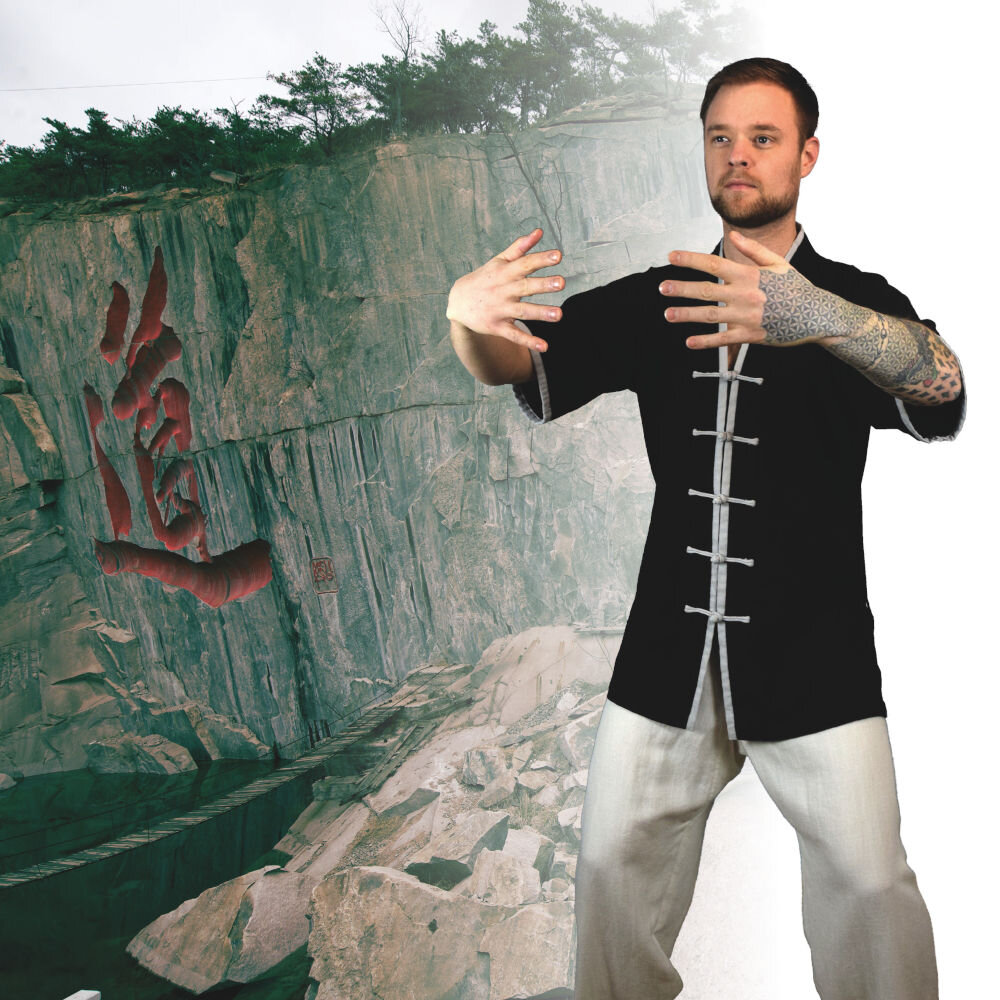Demystified! - Standing Pole Exercise (Zhan Zhuang) for martial artists
Understanding Zhan Zhuang Gong as a martial artist.
Whether you practice internal martial arts or Qigong for health purposes, Zhan Zhuang is an essential part for developing health, strength and a great sense of body-awareness. The martial artist will slowly narrow the center line of the body and tap into full body connected power. Practitioners for health purposes will be able to identify the most subtle physical and energetic blockages or tensions and promote increased circulation through deep relaxation.
But before I go more into detail, first a bit of history!
The origin of the Zhan Zhuang Qigong practice (also known as standing pole or hugging the tree exercise) can be traced back as far as the 3rd century BC, though it’s debatable as to when exactly the system was developed, and by whom. In fact it’s unsure what Zhan Zhuang was originally developed for. However, The Yellow Emperor's Inner Classic (Huangdi Neijing, 黃帝內經) which is the most important ancient text in Chinese medicine as well as a major book of Daoist theory and lifestyle, suggests that the performed static standing exercises were practiced to cultivate inner peace, health and to balance the body.
In the early Qing dynasty (17th century) this practice was widely spread and commonly practiced by the Shaolin monks. Even though it was not exactly the same version as the standing pole exercise as we know it today, at first glance, the concept seemed the same. The Shaolin warrior would maintain a single posture for a long period of time, essentially a “horse-stance” which was supposedly held until one doesn’t feel any discomfort or fatigue anymore. Everyone who has spent a few minutes in a horse-stance knows that this practice is mainly strengthening the legs and lower back and maintaining relaxation is a more than difficult task. Through diligent practice you will be able to cultivate a very low centre of gravity and firm root which allows your body to stand very stable and well balanced.
San Ti Shi Stance
These days we know that a “relaxed tension” is one of the key features of Zhan Zhuan, however, looking at the execution of these exercises from back in the day, they seem to have had little to do with relaxation and internal self-cultivation or nurturing tranquility and health. Static standing exercises have been adapted by many martial arts styles. However, it wasn’t until the development of the “San Ti Shi” (Heaven, Earth & Body- Stance), which belongs to the practice method of Xingyi Quan (Form and Will-Boxing) that the principles of relaxed nurturing of strength and physical conditioning were combined. It is believed that through this knowledge of the previous static Qigong exercises, in particular, San Ti Shi, Wang Xiangzhai then developed the standing pole practice as we know it today. Master Wang Xiangzhai (1885-1963) was a master of the martial art Xingyi Quan and the founder of Yiquan which was developed through his experiences of Zhan Zhuang Gong. In Yiquan the focus is on developing one’s natural movement and fighting abilities by improving perception of one’s body, its movement and of force.
At Water Dragon Arts we offer various courses that deal extensively with Qigong and Taijiquan. You can take part in our online lessons via Zoom or a selection of multi-day courses.
The concept of Zhan Zhuang in martial arts.
There is a concept in the internal martial arts that movement is inside stillness and stillness inside movement. In order to gain a deeper understanding of this concept I suggest reading the posts “The Concept of Qi” for learning about internal energy and “The Concept of Yi” for understanding the connection between this energy and the mind. If we assume a static position like San Ti Shi for example, there is also a potential to create movement. It is as if your body is standing in the starting position for a particular action, your muscles are energized and you are experiencing a certain “readiness”. At the very least we have to realize that this person, standing still is having potential energy. At any time this person could, through releasing, create kinetic energy and fall to the ground. Of course this example is only to highlight that unrelated to contracting muscles in the body, the body is also holding a potential of energy.
Some styles are utilizing this very idea to create movement using this different “engine”, not muscles and tendons, but the potential energy stored in a posture. You can think of this engine as “gravity power” which can be used for example, as “falling” steps (often seen in Chen Taijiquan) or as different postural releases in which the martial artist is throwing the opponent. So gravity plays an important role in the creation of potential energy, but it can also be utilized in different ways. This gravity can be used to put tension on the major tendon lines of the body and on the tissues throughout. This trains the whole constitution of the body and the tissues and muscles fibre will get an elastic and strong quality and capable of holding higher volumes of potential energy.
Zhan Zhuang as a fundamental exercise for internal martial arts
First of all, Zhan Zhuang is very helpful to condition the body into the correct postural alignment. The process of “flattening the lumbar curve” is considered important in order to increase your power through a entirely connected body. Important cues to stand in this posture correctly is the tilting of the pelvis and bringing down the tailbone. However, these cues potentially lead the students to tense the psoas muscle. That’s why it is important to remember relaxing the buttocks at the same time and let it hang down like a weight on the coccyx.
I personally wouldn’t go as far as claiming that the standing pole meditation is “the ultimate way” to build a foundation for internal martial arts, but I believe it is an essential corner stone which can teach us a wide range of things about ourselves. At the very least, I believe that static postures are necessary to create the awareness of the body and its connection with the lower Dan Tian. With the knowledge about the constitution of our bodies, we will be able to train more effectively.
Another important fact is that standing pole exercises (should) closely adhere to the principles of the Yijin Jing and Shenfa, the method of body-development Qigong. This means it is necessary to practice them according to the guidelines which are given to us by the ancient texts. In Zhan Zhuang you should try to relax the muscles so that they hang and stretch off of the bones. Muscle and bone will separate from each other. Bones up or away from each other (open joints) and flesh (muscles, tissues) down, the muscles relax and “hang”. This is the most important principle in body development. Read my post about the inner workings of the Yijin Jing to learn more.
How to increase the potential energy and transform it into power.
Essentially you can picture the body as one unit and imagine a web of tissues, different elastic bands and sheets of fascia. From what we have learned this interconnected web is full of potential to create motion, and training it will cultivate stronger potential of power. San Ti Shi, Zhan Zhuang and the postures of the Yijin Jing all focus on stretching major tendon lines and tissues of the body. These lines are all leading back to the centre, the lower Dan Tian, which acts like a major connection point for all motion created. This centre can sink, tilt or rotate. When this action occurs and the body is held static, you are basically loading this web with potential energy. - This energy can be transformed into power if the practitioner chooses to release the tension.
Through awareness we develop a natural connection and engage the whole body.
Generally speaking, most people loose the awareness of their bodies. It will stop working as one unit, and movements will be segmented. It is common in today’s society that people become disconnected from their bodies. That’s why, the novice, first needs to reclaim their sense of awareness and develop it to a high degree. If we look at the “Cloud Hands Exercise” in a Taiji form for example, you might see a beginners hand hanging soft “like dead” or the foot hangs loosely during a step. In order to move our body in unity we need to create a good sense of awareness. Simply by placing our awareness on a specific area in the body we will be able to engage this part. The hand will become alive and the action of moving it in this state of “readiness” will be executed with the correct amount of effort. With the awareness on your foot during a step, the foot will be engaged and actively searching for gripping the ground. This awareness, though it is extremely hard to apply during motion, is an important part of practice. With diligent training it will eventually become a natural reaction, a habit which will always maintain the correct state of each part of your body during motion. When we stand still in Zhan Zhuang, we are able to practice this microscopic awareness. When we scan the whole body from the top of the head to the toes, we will make the whole body engaged and start seeing the requirements of each body part necessary to go through complex motions.
In the drawing above you can see the general alignment for Zhan Zhuang practice. This position is the beginning point of practice and will help you narrow down the centre line of your body. However, after enough practice you will be able to sit back further into the Kua which will change the alignment slightly.
For a complete Zhan Zhuang course that includes 18 video lessons and more theoretical research and instruction material, click below.






